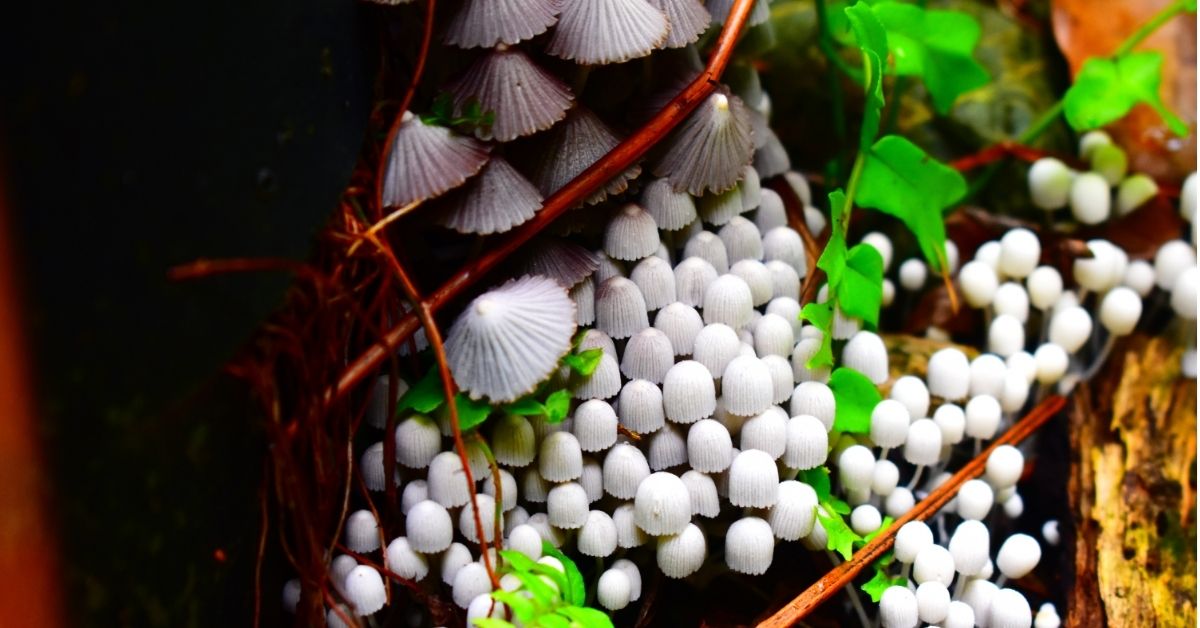Fungi identification can be a very mysterious world of wild mushrooms. There are close to 15,000 types of wild fungi in the UK. Our guide aims to help you identify the best to eat and the most important ones not to pick.
If you want to learn how to identify mushrooms, it’s important to know that a lot of accurate identification comes down to the fine details. For example, the colour of a mushroom’s spores, gills or stem can be crucial to helping you decide whether a mushroom is safe to eat.
But, it’s also important to remember that some fungi can be deadly poisonous to humans and animals. So, if you’re not sure about the type of mushroom you’ve found, it’s always best to err on the side of caution.
What to Look for When Identifying Mushrooms
If you’re just getting started with mushroom ID, the vast array of colors, shapes, and sizes can be overwhelming. But don’t worry! There are a few key characteristics you’ll want to focus on when identifying mushrooms.
• Cap: The shape, size, and color of the cap is one of the first things you’ll want to look at.
• Gills: Underneath the cap, you’ll find the gills. The color, shape, and spacing of the gills can be a helpful identification tool.
• Spore print: Making a spore print is a simple but crucial step in mushroom identification. The color of the spores can help narrow down the species.
• Stalk: The length, shape, and color of the stalk can be used to differentiate between different types of mushrooms.
• Base: The base of the mushroom, also known as the “volva,” can be used to identify the species.
• Smell: The smell of the mushroom can be a key identification tool. However, it’s important to be cautious when smelling mushrooms, as some species are poisonous.
• Habitat: Mushrooms grow in a variety of different environments, and the habitat can be a helpful identification tool.
• Time of year: Most mushrooms have a specific fruiting season. The time of year you find a mushroom can help you narrow down the species.
The 8 Most Common Mushrooms and How to Identify Them
Mushrooms come in all shapes, sizes, and colors. Some are edible, while others are toxic. And some are even known to have medicinal properties!
If you’re new to mushroom hunting, there are a few common mushrooms that you’re likely to come across. These mushrooms are a great place to start for beginners. Just remember, never eat a wild mushroom unless you are 100% certain of its identification!
Here are eight of the most common mushrooms and how to identify them.
1. Shaggy Mane (Coprinus comatus)
The shaggy mane is a common and easy-to-identify wild mushroom that’s also a choice edible. It’s a good mushroom to start with when you’re learning to identify wild mushrooms.
The shaggy mane gets its name from the long, shaggy scales that cover its cap. This is a great identifying feature. The cap is initially shaped like a small, round ball, but as the mushroom grows, it expands and the scales begin to turn upwards.
Shaggy manes are also known for their quick decomposition. After a few days of picking or after heavy rainfall, the cap begins to turn black and release a black inky fluid.
2. Oyster Mushroom (Pleurotus ostreatus)
This is one of the most popular types of wild mushrooms to forage for, and with good reason! Oyster mushrooms are easy to identify, and they’re also delicious. They are white or light brown, and they have a shelf-like appearance with a soft, velvety texture. You can find oyster mushrooms growing on trees, stumps, and logs.
3. Lion’s Mane (Hericium erinaceus)
Lion’s mane mushrooms are easy to recognize due to their long, shaggy tendrils that resemble a lion’s mane. This mushroom is a type of tooth fungus, which means it does not have gills or pores on the underside of the cap. Instead, it has downward-facing spines that resemble teeth.
Lion’s mane mushrooms are known for their medicinal benefits. They have been used in traditional Chinese medicine for centuries to support brain health, boost the immune system, and reduce inflammation. Research has shown that lion’s mane mushrooms contain compounds that can stimulate the growth of brain cells and protect against neurodegenerative diseases.
In addition to their health benefits, lion’s mane mushrooms also have a delicate, lobster-like flavor and a meaty texture, making them a popular choice for plant-based meat substitutes. You can use lion’s mane mushrooms in a variety of dishes, such as stir-fries, tacos, and pasta.
4. Chicken of the Woods (Laetiporus)
Chicken of the Woods is a type of bracket fungus that grows on trees, including eucalyptus, oak, and yew. It is easy to identify by its bright orange, yellow, and white coloring and the fact that it doesn’t have gills. Instead, this type of mushroom has small pores on the underside of its cap.
Chicken of the Woods is known for its lemony flavor and meat-like texture, making it a popular choice for plant-based recipes. It is also used in herbal medicine to treat a variety of health issues, including digestive problems and the common cold. However, it is important to note that some people may experience allergic reactions to this type of mushroom.
5. Morel (Morchella)
Morels are a highly sought-after edible mushroom. They are hollow inside, and their cap is attached to the stem at the bottom of the cap. They have a honeycomb appearance and can vary in color from a light tan to almost black.
There are a few toxic lookalikes, so it’s important to be 100% certain you have identified a morel before consuming it.
Morels are often found in wooded areas in the spring. They are a short-lived mushroom that can appear quickly and disappear just as fast.
There are many different species of morels and they all have slightly different characteristics. Some morels are even found in the fall!
6. Chanterelle (Cantharellus)
Chanterelles are some of the most popular mushrooms to forage for. These mushrooms are known for their bright orange color and their funnel-shaped cap.
Chanterelles are often found in the soil and are mycorrhizal. This means that they have a symbiotic relationship with the trees and plants they grow near.
There are many species of chanterelles, and they are found all over the world. The most common types of chanterelles in North America are the golden chanterelle (Cantharellus cibarius) and the Pacific golden chanterelle (Cantharellus formosus).
7. Reishi (Ganoderma lucidum)
Reishi mushrooms are a type of polypore mushroom that grow on trees and are known for their bright red color and glossy appearance. Reishi mushrooms are also known as the “mushroom of immortality” and have been used in traditional Chinese medicine for centuries.
Reishi mushrooms are typically too tough to eat, but you can make a tea or tincture out of them. They are thought to have a number of health benefits, including boosting the immune system and reducing stress.
8. Turkey Tail (Trametes versicolor)
In the world of fungi, turkey tails are some of the most easily recognizable mushrooms. These colorful fungi grow in layers on dead or dying wood, and are often found in large clusters.
Turkey tail mushrooms come in a variety of colors, including white, gray, and shades of brown. The name “turkey tail” comes from the fact that the mushrooms have a fan-like shape and are often covered in bands of color, resembling the tail feathers of a turkey.
In addition to being beautiful, turkey tails are also medicinal. These mushrooms have been used in traditional Chinese medicine for centuries, and are believed to have immune-boosting properties. While turkey tail mushrooms are not typically eaten, they can be used to make a healthy and delicious tea!
Conclusion
There are many types of mushrooms. Some are edible, some are medicinal, and some are poisonous. In order to make the most of the mushrooms that you find, it’s important to be able to identify them.
We hope this article has been helpful in providing you with some information on how to identify mushrooms. If you have any questions, please feel free to reach out to us.
If you are a professional who needs help with your content strategy, please reach out to us to learn more about how our platform works.





